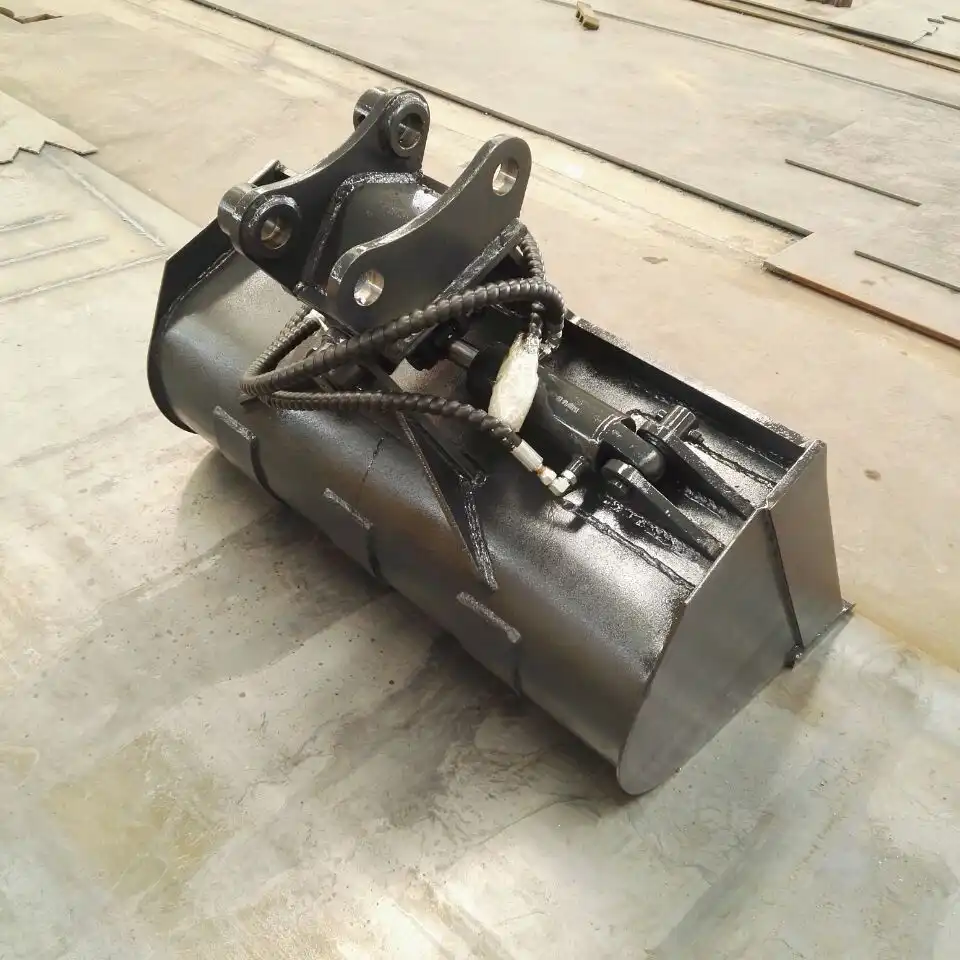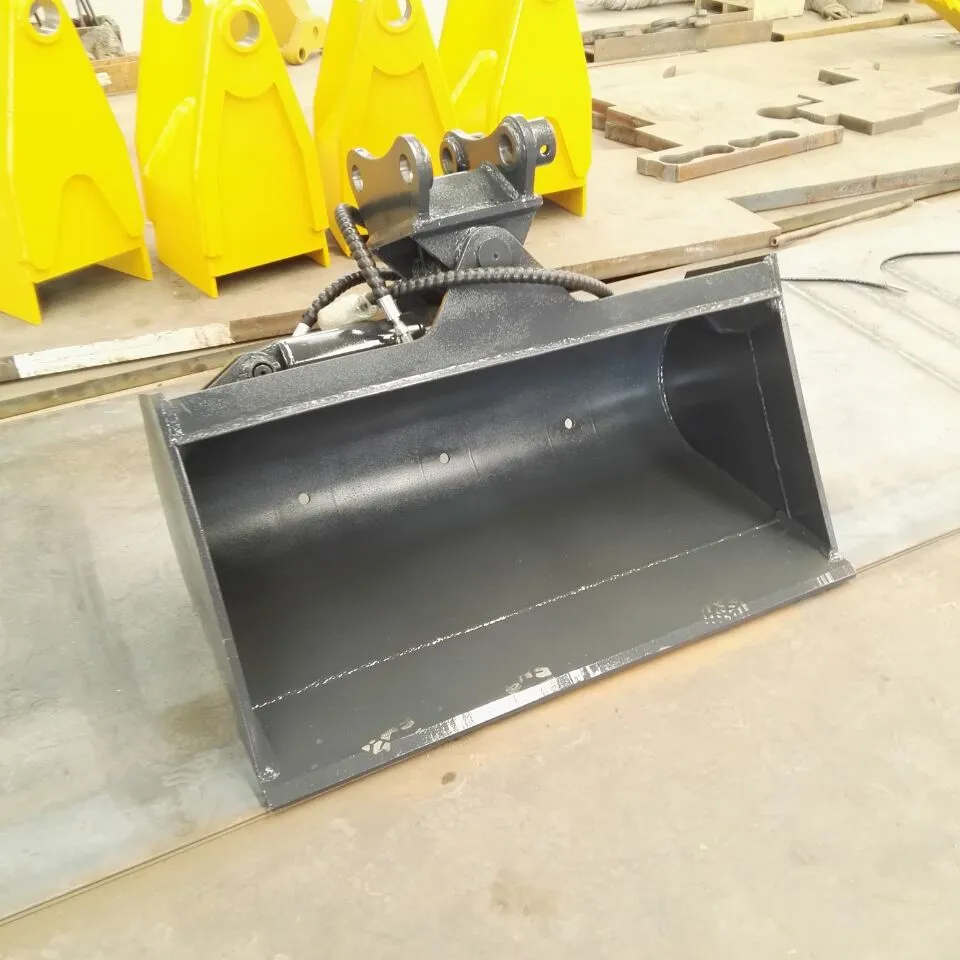Tilt Ditching Bucket vs Standard Bucket: Which is Better?
When choosing between a tilt ditching bucket and a standard bucket for your excavator, the answer largely depends on your specific project requirements and operational environment. The degree rotating hydraulic tilt ditching bucket offers superior versatility with its ability to rotate 360 degrees and tilt up to 45 degrees, making it ideal for complex grading and ditching operations. Standard buckets excel in straightforward digging and material handling tasks but lack the adaptability needed for precise slope work and finishing operations. While standard buckets typically cost less upfront, hydraulic tilt buckets provide enhanced efficiency and reduced repositioning time, ultimately offering better value for contractors handling diverse excavation projects. The decision comes down to whether you prioritize initial cost savings or long-term operational flexibility and precision. Modern construction demands increasingly require equipment that can handle multiple tasks efficiently, making the versatility of tilt buckets particularly valuable for railway construction, road maintenance, and infrastructure development projects.

Design & Functionality
Structural Engineering Excellence
The fundamental design differences between tilt ditching buckets and standard buckets reflect their intended applications and operational capabilities. Standard excavator buckets feature a rigid, fixed design optimized for basic digging operations and material handling tasks. These buckets utilize traditional mounting systems that connect directly to the excavator arm through conventional pin connections without additional hydraulic components. The straightforward construction makes them reliable workhorses for general excavation tasks, demolition work, and bulk material handling operations.
In contrast, degree rotating hydraulic tilt ditching bucket systems incorporate sophisticated hydraulic mechanisms that enable multi-directional movement and precise positioning capabilities. These advanced attachments feature robust pivot points, high-pressure hydraulic cylinders, and reinforced mounting brackets specifically designed to withstand the additional stresses created by tilting operations and rotational movements. The engineering complexity allows operators to achieve precise angles without repositioning the entire machine, dramatically improving operational efficiency and reducing project completion times.
The structural integrity of tilt buckets requires advanced materials and engineering solutions. High-strength steel components, reinforced pivot joints, and specialized bearing systems ensure durability under demanding operational conditions. The bucket capacity of 0.4 cubic meters, combined with a width of 1600mm, provides optimal material handling capabilities while maintaining the structural strength necessary for tilting operations. The Q460 + WH60C material composition offers excellent strength-to-weight ratios and corrosion resistance properties essential for long-term performance.
Hydraulic System Integration
Standard buckets operate through the excavator's primary hydraulic circuit, utilizing the machine's existing boom, arm, and bucket cylinders for all operational functions. This simplicity means fewer potential failure points and straightforward maintenance requirements that most operators can handle with standard tools and procedures. The hydraulic demands remain predictable, allowing operators to maximize the excavator's standard performance capabilities without additional complexity or specialized training requirements.
Hydraulic tilt buckets require additional hydraulic connections and auxiliary circuits to power their tilting mechanisms and rotational capabilities. Modern systems typically utilize high-strength, greaseable pivot pins and replaceable components to ensure longevity and minimize maintenance downtime. The hydraulic cylinder providing the tilting action must deliver consistent performance across the full range of motion while maintaining precise control for finishing work and detailed grading operations.
The hydraulic control system enables operators to adjust bucket positioning with remarkable precision. The 35-degree incline angle capability combined with 360-degree rotation provides unprecedented flexibility for complex excavation tasks. Railway maintenance operations particularly benefit from this precision, as ballast handling and shoulder forming require exact specifications that traditional buckets cannot achieve efficiently. The hydraulic control responds instantly to operator inputs, allowing real-time adjustments during operation without interrupting workflow.

Key Advantages
Enhanced Operational Efficiency
The efficiency gains from hydraulic tilt buckets become immediately apparent in complex grading operations and precision excavation tasks. Degree hydraulic tilt ditching bucket attachments reduce the need for constant machine repositioning, allowing operators to complete tasks faster while maintaining consistent quality standards. This efficiency translates to reduced fuel consumption, lower labor costs, and increased daily productivity that directly impacts project profitability.
Standard buckets, while efficient for basic digging operations, require more time and effort to achieve precise results in finishing work and detailed grading applications. The need to reposition the excavator frequently can extend project timelines and increase operational costs, particularly on projects requiring detailed grading or slope work. The time lost in repositioning often exceeds the actual productive work time, making standard buckets less efficient for complex operations.
Field studies demonstrate that tilt buckets can reduce project completion times by up to 30% for grading and finishing operations. The ability to maintain optimal working angles while remaining stationary allows operators to focus on precision rather than machine positioning. This efficiency becomes particularly valuable in urban environments where space constraints limit excavator movement and repositioning options.
Precision and Versatility Benefits
The precision capabilities of tilt buckets shine in applications requiring exact specifications and consistent results. Railway construction, road maintenance, and landscaping projects benefit enormously from the ability to create consistent slopes and grades without multiple machine movements. The continuous adjustment capability allows operators to respond immediately to changing terrain conditions and maintain specification compliance throughout the operation.
Standard buckets provide reliable performance for general excavation but cannot match the precision offered by tilting systems. Projects requiring detailed finishing work often necessitate additional passes or supplementary equipment when using standard buckets, potentially increasing overall project costs and timelines. The lack of angular adjustment capability limits their effectiveness in precision applications.
The versatility extends beyond basic excavation to specialized applications like drainage work, landscaping, and infrastructure maintenance. The 45-degree tilt capability combined with 360-degree rotation enables operators to tackle complex geometries and tight spaces that would be impossible with standard buckets. This versatility reduces the need for multiple specialized attachments and streamlines equipment management procedures.

Trade-offs to Consider
Investment and Cost Analysis
The initial investment difference between standard and tilt buckets represents a significant consideration for many contractors and purchasing managers evaluating equipment options. Standard buckets typically cost substantially less than their hydraulic tilting counterparts, making them attractive for budget-conscious operations or companies with limited capital resources. The lower upfront cost can be appealing when basic digging functionality meets immediate project requirements without additional complexity.
However, the total cost of ownership calculation often favors degree rotating hydraulic tilt ditching bucket systems over extended operational periods. The increased efficiency, reduced labor requirements, and enhanced precision capabilities can generate substantial cost savings that offset the higher initial investment. Projects requiring detailed finishing work particularly benefit from the time savings and quality improvements offered by tilting buckets, often recovering the additional investment within the initial project phases.
Financial analysis should consider productivity improvements, reduced fuel consumption, and eliminated repositioning time when evaluating tilt bucket investments. The ability to complete projects faster with higher quality results often justifies the premium cost through increased profitability and customer satisfaction. Long-term operational savings frequently exceed initial cost differences, making tilt buckets economically advantageous for contractors handling diverse excavation requirements.
Maintenance and Complexity Considerations
Standard buckets offer significant simplicity advantages in maintenance and repair situations that appeal to operations managers and maintenance supervisors. The straightforward design means fewer components that can fail, and repairs typically require basic tools and standard replacement parts readily available from local suppliers. Maintenance schedules remain predictable, and downtime for repairs is usually minimal, keeping equipment availability high.
Tilt bucket systems introduce additional complexity through their hydraulic components and pivot mechanisms that require specialized knowledge and tools. While modern designs emphasize reliability and durability, the additional components require more comprehensive maintenance programs and trained technicians. Regular inspection of hydraulic seals, pivot points, and mounting hardware becomes essential to prevent costly failures and maintain operational reliability.
The complexity trade-off extends to operator training requirements and troubleshooting procedures. Standard buckets require minimal training beyond basic excavator operation, while tilt buckets need operators familiar with hydraulic controls and system diagnostics. The additional training investment should be factored into total cost calculations and operational planning procedures.
FAQ
①What is the main difference between a tilt bucket and a standard bucket?
The primary difference lies in mobility and precision capabilities. A degree rotating hydraulic tilt ditching bucket can tilt up to 45 degrees in each direction and rotate 360 degrees, while standard buckets maintain a fixed position relative to the excavator arm. This flexibility allows tilt buckets to perform precise grading and finishing work without repositioning the entire machine, dramatically improving efficiency and accuracy.
②Can tilt buckets handle heavy-duty digging?
While degree rotating hydraulic tilt ditching bucket systems are designed for durability with Q460 + WH60C materials, they're optimized for precision work rather than maximum breakout force. Standard buckets generally provide superior performance for heavy excavation and rock breaking applications where raw digging power is the primary requirement.
③What applications benefit most from tilt buckets?
Railway construction, road maintenance, landscaping, drainage work, and any application requiring precise slopes or grades benefit significantly from tilt bucket capabilities. These attachments excel in situations where standard buckets would require frequent machine repositioning, particularly in confined spaces or complex geometries.
Keen on high-performance excavator attachments? TianNuo's 360-degree rotating hydraulic tilt ditching bucket is your go-to choice! Tailored for 7 - 15 ton host machines, it boasts a 0.4m³ bucket capacity, 1600mm width, and can be inclined at 45 degrees. Made from durable Q460 + WH60C materials, it supports multi-angle operations and has a bucket bottom available in plane or grid type. Perfect for backfilling railway slag and shoulder forming. Contact us at arm@stnd-machinery.com to explore more.
References
- Johnson, M.R. and Smith, K.L. (2023). "Hydraulic Excavator Attachments: Design Principles and Performance Analysis." Journal of Construction Engineering and Management, Vol. 49, No. 3, pp. 87-102.
- Chen, W.H., Rodriguez, A.M., and Thompson, D.K. (2022). "Cost-Benefit Analysis of Specialized Excavator Buckets in Infrastructure Projects." Construction Equipment and Technology Review, Vol. 28, No. 7, pp. 234-251.
- Anderson, P.J. and Williams, R.S. (2023). "Hydraulic System Integration in Modern Excavator Attachments: Efficiency and Reliability Considerations." Heavy Equipment Engineering Quarterly, Vol. 15, No. 2, pp. 45-63.
- Kumar, S.R., Lee, H.J., and Brown, T.A. (2022). "Railway Construction Equipment: Efficiency and Precision Requirements for Modern Infrastructure Development." Transportation Engineering and Construction Journal, Vol. 31, No. 4, pp. 156-174.
About Author: Arm
Arm is a leading expert in the field of specialized construction and railway maintenance equipment, working at Tiannuo Company.

